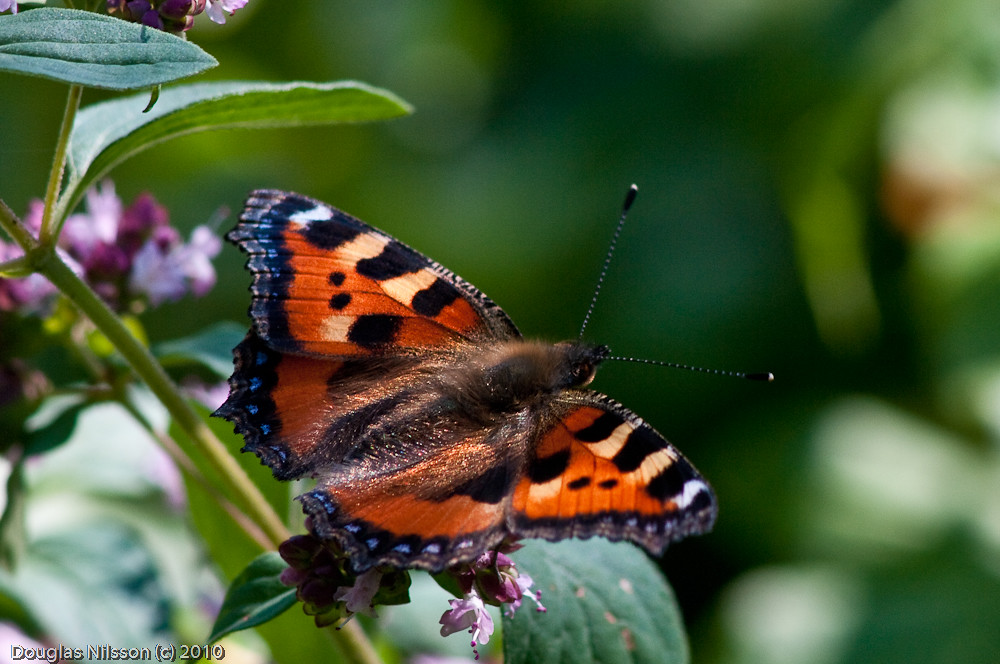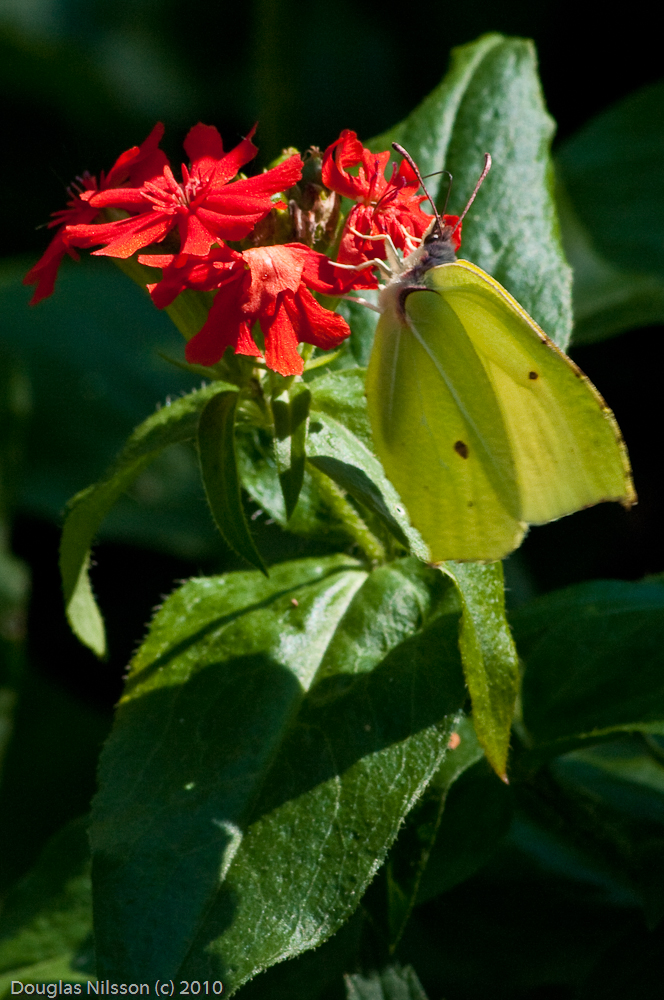What you need to shoot butterflies? A camera, a macro lens, butterflies (obviously) and patience. There are is course rules that apply. Macro work results in thin depth of focus (DOF). Actually so small that you are going to want to close down the lens as much as possible or else you wont be able to fit a whole bug within the DOF. On the other hand, bugs move, so you can't shoot with as long exposure time as you may do with a still object, like a flower. Longer lenses results in thinner DOF, but it also change the distance you can work at. Supposedly, the same framing should result in the same DOF at a given apperture. Longer lenses makes it more difficult to hold the camera steady enough to get a sharp shot. Shake reduction has partly changed this, but the same rule applies, except that you now can shoot sharp at about two steps longer exposure time than before. But there is another rule that over-rules all these optical rules:
The relationship between the lens and the amount of patience you need. Most butterflies are shy and will leave if even your shadow touch it. The relationship is approximately
Patience = 1 / (f x f)
where f is the focal length. So a 100mm lens requires only 1/4th of the patience you need to shoot butterflies with a 50mm lens. A 200mm lens would make do with 1/16th of the patience.
However, the really long macro lenses are rare and usually more expensive. Pentax made two 200mm macro lenses, the SMC Pentax-A*200 f4 macro 1:1 (manual focus) and the SMC Pentax-FA*200mm f4 macro 1:1 (autofocus). The "*" denotes Pentax highest grade or professional serie. These are both considered among the best long macro lenses ever made, partly because of a high ability to produce a smooth bokeh that helps isolate the subject. Unfortunately both are out of production and a high demand on the second hand market and because these lenses are rare, results in high prices. The FA*200 was supposedly only made in 1100 copies for the whole global market, and some copies are for sure living a useless life among collectors, and others have been converted for use on Canon's EOS bodies. The only current lens in this class made for Pentax are the Sigma 180mm f3.5 macro 1:1 lens, but Sigma has problems producing enough copies, and the queue to get one is long. So what to do? When I sneak around with my 35, 50, 90 and 100mm macro lenses the butterflies and dragonflies escape before I get enough of them in the viewfinder, or I end up cropping too much to maintain quality. Sitting for hours at a popular flower waiting for a butterfly to land there do work, but that is where the "patience-equation" comes in. Sometimes I have patience enough, sometimes not, and to complicate things, even if I do, my wife or kids may not (and I don't blame them).
Until now I've been playing around with converters on my 90 and 100mm macro lenses (resulting in a manual focus 180mm f5 or a 170mm ~f4.8. Optically compromises, as always with converters, even dedicated such as in the case of the Tamron Adaptall 2 SP 90mm f2.5 macro 1:2, and rather slowis/darkish. So what to do? I don't have the budget for an A* or FA* macro.
The two first images are of a small tortoiseshell ("nässelfjäril" in Swedish) feeding on an oregano flower. Like the rest of the photos of this post, they are shot with a 200mm macro of another brand, on an adaptor, a lens corresponding to the manual A*200mm. We are talking about the Canon FD 200mm f4 macro 1:1 lens. As Canon totally abandoned their FD mount when going into autofocus with the EOS mount, the prices are much lower than corresponding Pentax lenses (partly because these are still fully compatible with the Pentax digital SLRs). I'm mounting the Canon lens with help of a SCOPTIC made FD-K mount adapter that can be baught on the web very sheap. To maintain infinity focus it has an optical element that "enlarge" the picture a factor ~1.4. This makes the lens a ~280mm f5.6, and cause some optical degrading (see this thread on the Pentax forum). But the lens element is easy to remove, and while I loose infinity focus, it focus up to severall meter away, which is enough for macro work. I lose inifinty but gain speed and quality, and the lens remain a 200mm f4 lens, though it is now capable of a little bit more than 1:1 macro (the adapter and the difference in registration distance between the K mount and the FD mount act as were they small extension tubes). I've either shot on manual with flash or on Tv and the lens stopped down to f8 or f11 in natural light.
Below follows a Cabbage butterfly (large white or in Swedish Kålfjäril) and a common brimmstone (citronfjäril in Swedish) feeding on a Silene chalcedonica. I've also got unprocessed with this lens shots of a silver-washed fritillary (silverstreckad pärlemorfjäril) and the European peacock (påfågelöga) that I may add to this post later on. More shots in my flickr and in a Pentax forum thread.
BOH!
Until now I've been playing around with converters on my 90 and 100mm macro lenses (resulting in a manual focus 180mm f5 or a 170mm ~f4.8. Optically compromises, as always with converters, even dedicated such as in the case of the Tamron Adaptall 2 SP 90mm f2.5 macro 1:2, and rather slowis/darkish. So what to do? I don't have the budget for an A* or FA* macro.
The two first images are of a small tortoiseshell ("nässelfjäril" in Swedish) feeding on an oregano flower. Like the rest of the photos of this post, they are shot with a 200mm macro of another brand, on an adaptor, a lens corresponding to the manual A*200mm. We are talking about the Canon FD 200mm f4 macro 1:1 lens. As Canon totally abandoned their FD mount when going into autofocus with the EOS mount, the prices are much lower than corresponding Pentax lenses (partly because these are still fully compatible with the Pentax digital SLRs). I'm mounting the Canon lens with help of a SCOPTIC made FD-K mount adapter that can be baught on the web very sheap. To maintain infinity focus it has an optical element that "enlarge" the picture a factor ~1.4. This makes the lens a ~280mm f5.6, and cause some optical degrading (see this thread on the Pentax forum). But the lens element is easy to remove, and while I loose infinity focus, it focus up to severall meter away, which is enough for macro work. I lose inifinty but gain speed and quality, and the lens remain a 200mm f4 lens, though it is now capable of a little bit more than 1:1 macro (the adapter and the difference in registration distance between the K mount and the FD mount act as were they small extension tubes). I've either shot on manual with flash or on Tv and the lens stopped down to f8 or f11 in natural light.
Below follows a Cabbage butterfly (large white or in Swedish Kålfjäril) and a common brimmstone (citronfjäril in Swedish) feeding on a Silene chalcedonica. I've also got unprocessed with this lens shots of a silver-washed fritillary (silverstreckad pärlemorfjäril) and the European peacock (påfågelöga) that I may add to this post later on. More shots in my flickr and in a Pentax forum thread.
BOH!








.jpg)







